Page 240 of 420

WARNING
Before towing, turn the ignition key to
MAR and then to STOP without
removing it .The steering column will
automatically lock when the key is removed and
the wheels cannot be steered.
WARNING
Before tightening the hook clean the
threaded housing thoroughly. Make sure
that the hook is fully fastened in the housing
before towing the car.
WARNING
Whilst towing, remember that the
assistance of the brake servo and the
electric power steering is not available,
therefore greater force needs to be exerted on
the brake pedal and more effort is required
on the steering wheel. Do not use flexible cables
when towing and avoid jerky movements. Make
sure not to damage parts in contact with the
car while towing.When towing the vehicle, you
must comply with all specific traffic regulations
and adopt an appropriate driving behaviour.
Do not start the engine while towing the car.
fig. 210
F0Y0144
fig. 211 - Trekking versions
F0Y0364
236GETTING TO KNOW
YOUR CAR
SAFETY
STARTING AND
DRIVING
WARNING LIGHTS
AND MESSAGES
IN AN
EMERGENCY
SERVICING AND
MAINTENANCE
TECHNICAL
SPECIFICATIONS
INDEX
Page 241 of 420
237GETTING TO KNOW
YOUR CAR
SAFETY
STARTING AND
DRIVING
WARNING LIGHTS
AND MESSAGESIN AN
EMERGENCYSERVICING AND
MAINTENANCE
TECHNICAL
SPECIFICATIONS
INDEX
WARNING
The front and rear tow hooks should be
used only for emergencies on the road.
The car may be towed for short distances when
a dedicated device is used in compliance with
the Highway Code (rigid bar), and in order
to move the vehicle on the road in preparation
for towing or transport via a tow truck (on
the Trekking versions do NOT use the rear tow
hook for transport on a tow truck: use the front
tow hook).Tow hooks MUST NOT be used to
tow vehicles off the road or where there are
obstacles and/or for towing operations using
cables or other non-rigid devices. In compliance
with the above conditions, towing must take
place with the two vehicles (one towing, the
other towed) aligned as much as possible along
the same centre line.
Page 242 of 420
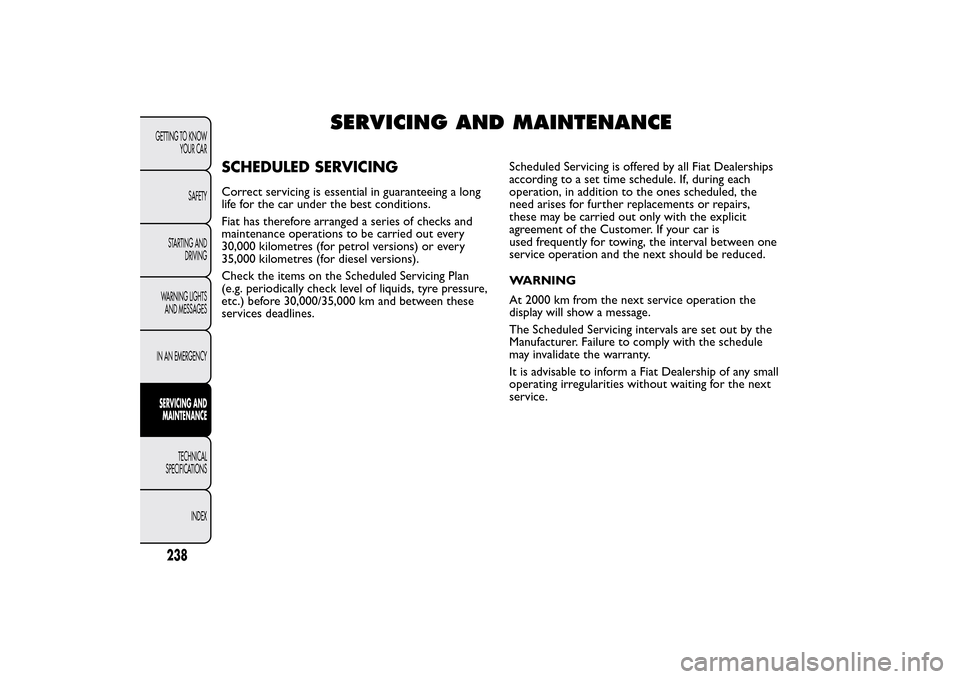
SERVICING AND MAINTENANCE
SCHEDULED SERVICINGCorrect servicing is essential in guaranteeing a long
life for the car under the best conditions.
Fiat has therefore arranged a series of checks and
maintenance operations to be carried out every
30,000 kilometres (for petrol versions) or every
35,000 kilometres (for diesel versions).
Check the items on the Scheduled Servicing Plan
(e.g. periodically check level of liquids, tyre pressure,
etc.) before 30,000/35,000 km and between these
services deadlines.Scheduled Servicing is offered by all Fiat Dealerships
according to a set time schedule. If, during each
operation, in addition to the ones scheduled, the
need arises for further replacements or repairs,
these may be carried out only with the explicit
agreement of the Customer. If your car is
used frequently for towing, the interval between one
service operation and the next should be reduced.
WARNING
At 2000 km from the next service operation the
display will show a message.
The Scheduled Servicing intervals are set out by the
Manufacturer. Failure to comply with the schedule
may invalidate the warranty.
It is advisable to inform a Fiat Dealership of any small
operating irregularities without waiting for the next
service.
238GETTING TO KNOW
YOUR CAR
SAFETY
STARTING AND
DRIVING
WARNING LIGHTS
AND MESSAGES
IN AN EMERGENCYSERVICING AND
MAINTENANCE
TECHNICAL
SPECIFICATIONS
INDEX
Page 247 of 420
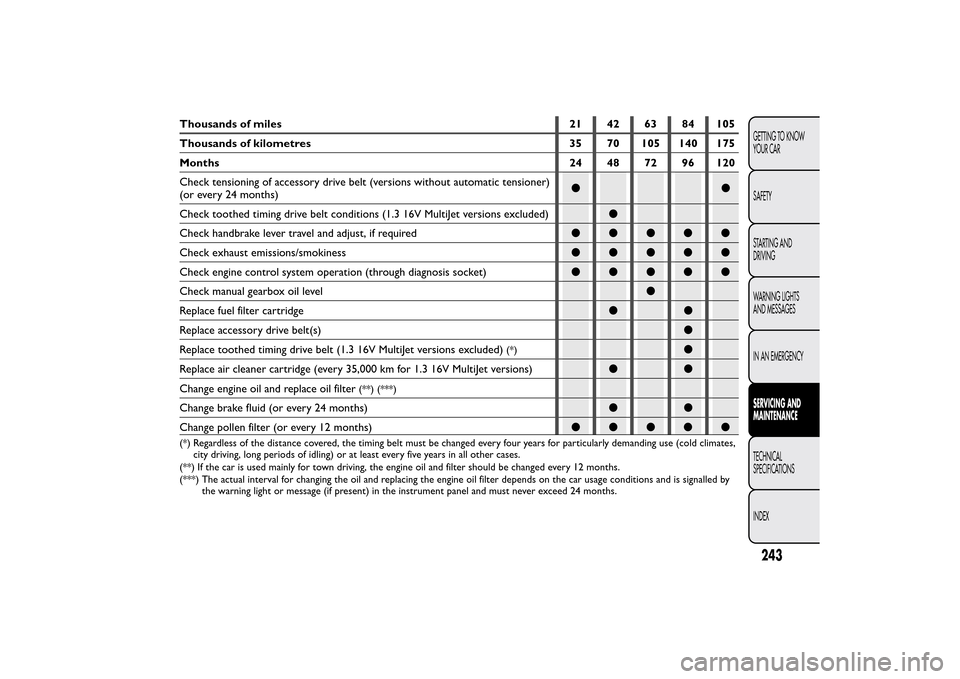
Thousands of miles 21 42 63 84 105
Thousands of kilometres 35 70 105 140 175
Months 24 48 72 96 120
Check tensioning of accessory drive belt (versions without automatic tensioner)
(or every 24 months)●●
Check toothed timing drive belt conditions (1.3 16V MultiJet versions excluded)●
Check handbrake lever travel and adjust, if required●●●●●
Check exhaust emissions/smokiness●●●●●
Check engine control system operation (through diagnosis socket)●●●●●
Check manual gearbox oil level●
Replace fuel filter cartridge●●
Replace accessory drive belt(s)●
Replace toothed timing drive belt (1.3 16V MultiJet versions excluded)
(*)
●
Replace air cleaner cartridge (every 35,000 km for 1.3 16V MultiJet versions)●●
Change engine oil and replace oil filter
(**) (***)
Change brake fluid (or every 24 months)●●
Change pollen filter (or every 12 months)●●●●●(*) Regardless of the distance covered, the timing belt must be changed every four years for particularly demanding use (cold climates,
city driving, long periods of idling) or at least every five years in all other cases.
(**) If the car is used mainly for town driving, the engine oil and filter should be changed every 12 months.
(***) The actual interval for changing the oil and replacing the engine oil filter depends on the car usage conditions and is signalled by
the warning light or message (if present) in the instrument panel and must never exceed 24 months.
243GETTING TO KNOW
YOUR CAR
SAFETY
STARTING AND
DRIVING
WARNING LIGHTS
AND MESSAGES
IN AN EMERGENCYSERVICING AND
MAINTENANCETECHNICAL
SPECIFICATIONS
INDEX
Page 248 of 420
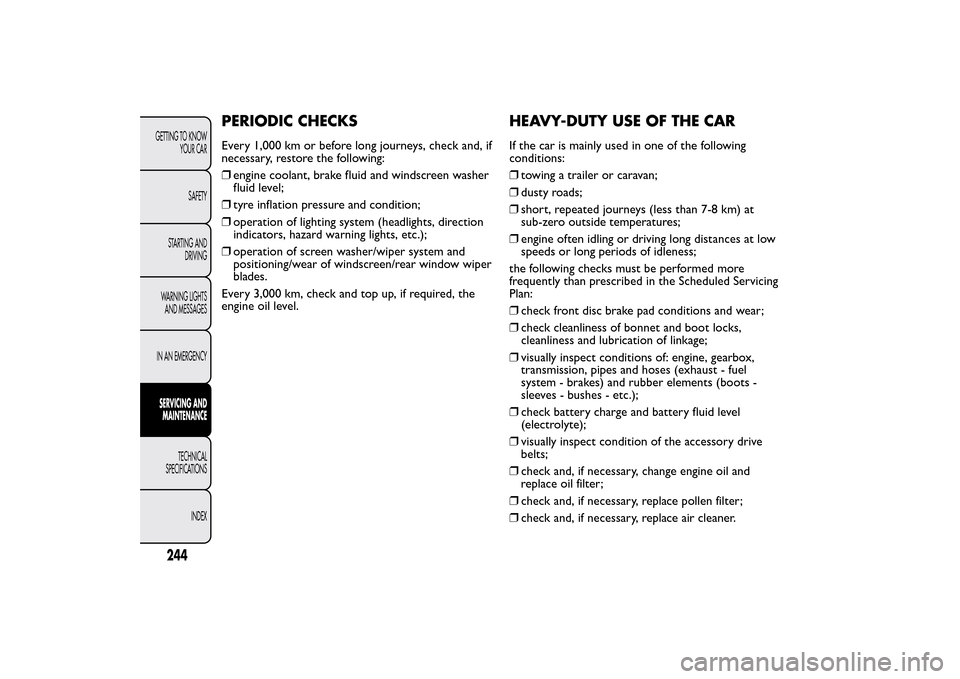
PERIODIC CHECKSEvery 1,000 km or before long journeys, check and, if
necessary, restore the following:
❒engine coolant, brake fluid and windscreen washer
fluid level;
❒tyre inflation pressure and condition;
❒operation of lighting system (headlights, direction
indicators, hazard warning lights, etc.);
❒operation of screen washer/wiper system and
positioning/wear of windscreen/rear window wiper
blades.
Every 3,000 km, check and top up, if required, the
engine oil level.
HEAVY-DUTY USE OF THE CARIf the car is mainly used in one of the following
conditions:
❒towing a trailer or caravan;
❒dusty roads;
❒short, repeated journeys (less than 7-8 km) at
sub-zero outside temperatures;
❒engine often idling or driving long distances at low
speeds or long periods of idleness;
the following checks must be performed more
frequently than prescribed in the Scheduled Servicing
Plan:
❒check front disc brake pad conditions and wear;
❒check cleanliness of bonnet and boot locks,
cleanliness and lubrication of linkage;
❒visually inspect conditions of: engine, gearbox,
transmission, pipes and hoses (exhaust - fuel
system - brakes) and rubber elements (boots -
sleeves - bushes - etc.);
❒check battery charge and battery fluid level
(electrolyte);
❒visually inspect condition of the accessory drive
belts;
❒check and, if necessary, change engine oil and
replace oil filter;
❒check and, if necessary, replace pollen filter;
❒check and, if necessary, replace air cleaner.
244GETTING TO KNOW
YOUR CAR
SAFETY
STARTING AND
DRIVING
WARNING LIGHTS
AND MESSAGES
IN AN EMERGENCYSERVICING AND
MAINTENANCE
TECHNICAL
SPECIFICATIONS
INDEX
Page 285 of 420
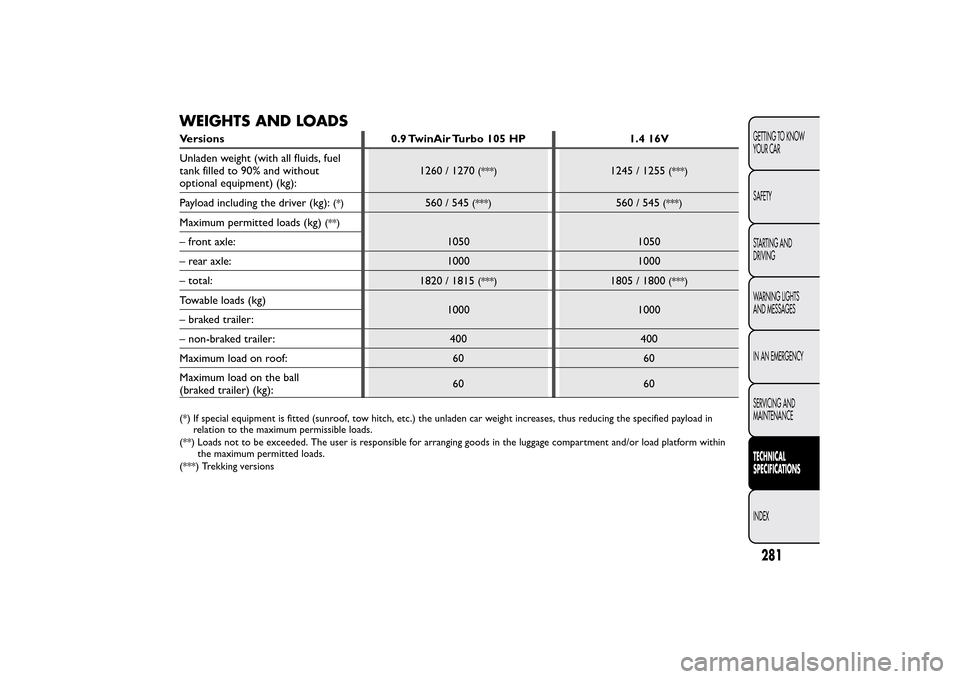
WEIGHTS AND LOADSVersions 0.9 TwinAir Turbo 105 HP 1.4 16V
Unladen weight (with all fluids, fuel
tank filled to 90% and without
optional equipment) (kg):1260 / 1270
(***)
1245 / 1255
(***)
Payload including the driver (kg):
(*)
560 / 545
(***)
560 / 545
(***)
Maximum permitted loads (kg)
(**)
1050 1050 – front axle:
– rear axle: 1000 1000
– total:
1820 / 1815
(***)
1805 / 1800
(***)
Towable loads (kg)
1000 1000
– braked trailer:
– non-braked trailer: 400 400
Maximum load on roof: 60 60
Maximum load on the ball
(braked trailer) (kg):60 60(***) Trekking versions (*) If special equipment is fitted (sunroof, tow hitch, etc.) the unladen car weight increases, thus reducing the specified payload in
relation to the maximum permissible loads.
(**) Loads not to be exceeded. The user is responsible for arranging goods in the luggage compartment and/or load platform within
the maximum permitted loads.
281GETTING TO KNOW
YOUR CAR
SAFETY
STARTING AND
DRIVING
WARNING LIGHTS
AND MESSAGES
IN AN EMERGENCY
SERVICING AND
MAINTENANCETECHNICAL
SPECIFICATIONSINDEX
Page 286 of 420
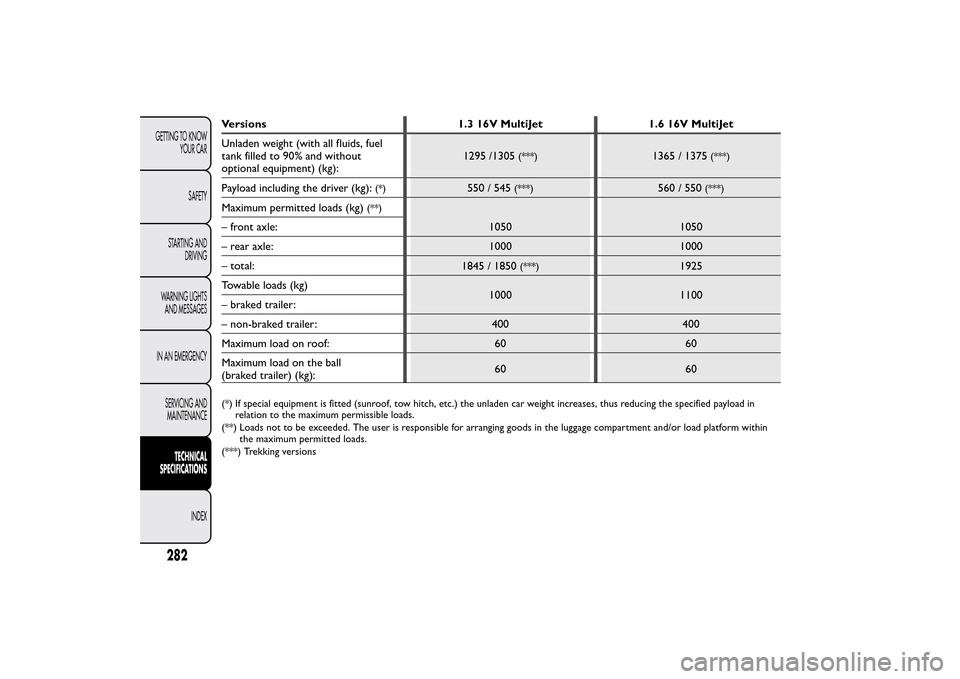
Versions 1.3 16V MultiJet 1.6 16V MultiJet
Unladen weight (with all fluids, fuel
tank filled to 90% and without
optional equipment) (kg):1295 /1305
(***)
1365 / 1375
(***)
Payload including the driver (kg):
(*)
550 / 545
(***)
560 / 550
(***)
Maximum permitted loads (kg)
(**)
1050 1050 – front axle:
– rear axle: 1000 1000
– total:
1845 / 1850
(***)
1925
Towable loads (kg)
1000 1100
– braked trailer:
– non-braked trailer: 400 400
Maximum load on roof: 60 60
Maximum load on the ball
(braked trailer) (kg):60 60
(***) Trekking versions (*) If special equipment is fitted (sunroof, tow hitch, etc.) the unladen car weight increases, thus reducing the specified payload in
relation to the maximum permissible loads.
(**) Loads not to be exceeded. The user is responsible for arranging goods in the luggage compartment and/or load platform within
the maximum permitted loads.
282GETTING TO KNOW
YOUR CAR
SAFETY
STARTING AND
DRIVING
WARNING LIGHTS
AND MESSAGES
IN AN EMERGENCY
SERVICING AND
MAINTENANCE
TECHNICAL
SPECIFICATIONS
INDEX
Page 313 of 420
THIRD ROW SEAT BACKREST
REPOSITIONING
Pull toward yourself devices A fig. 9 located behind
the rear seat backrests to reposition the seat
backrests.
IMPORTANT Before moving the backrests, make
sure that covers B are completely folded on the
backrest rear part.
IMPORTANT Do not move the third row seats
before removing the curtain (see "Curtain removal"
in paragraph "Luggage compartment").
WARNING
Make sure the backrests are properly
secured at both sides to prevent them
from moving forward, in the event of sharp
braking, with possible impact with the
occupants. A metallic click is heard when locking
is correct .
BOTTLE/CAN HOLDER COMPARTMENT
It is located between the third row rear seats fig. 10.
fig. 9
F0Y0378
fig. 10
F0Y0382
309